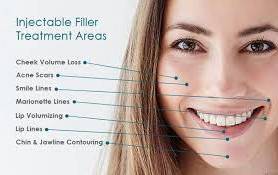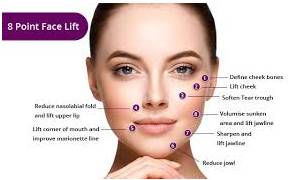As we age the skin naturally loses volume and elasticity, leading to the formation of folds and sagging. Commonly these will be in the most expressive parts of your face; around the nose and mouth. This loss of volume is due to diminishing Hyaluronic acid and Collagen.
Dermal fillers are injectable gels used to replenish the Hyaluronic acid and soften or plump facial lines.
Dermal filler can also be used to stabilise and lift areas of laxity, aiding with reshaping and contouring.
Products such as Juvederm® closely resemble our own Hyaluronic Acid; which makes it safe and natural looking. Your body then gradually and evenly dissolves the temporary fillers over 6-18 months (depending on the product and volume used).
Dermal Fillers can be used for a huge range of aesthetic treatments:
- Nose to mouth (nasolabial) lines
- Mouth to chin (marionette) lines
- Restoring or enhancing lip volume
- The 8 Point Face-lift
- Smoker’s lines
- Chin reshaping
- Cheek volumising&reshaping
Non-surgical rhinoplasty
- Jawline reshaping


As with any aesthetic procedure, it is absolutely essential that a full and comprehensive consultation is performed prior to any treatment. The consultation will always include your past medical and surgical history, lifestyle, allergies and medications. Pregnancy and breast feeding is an absolute contraindication to dermal fillers.
You will be asked to describe your concerns/problem areas and by having a thorough and honest conversation, we will plan your treatment journey.
Dermal fillers are an injectable and depending personal preference and the area being treated may require a local anaesthetic/numbing. There is very little down time and you can return to your day immediately after your appointment.
Results are immediate. Dermal fillers can be used directly or indirectly. The direct approach to dermal fillers is treating the line that you can see, or volumising a specific area (ie. Lips). The indirect approach to using dermal fillers can be equally, if not more, effective when conducted by someone with extensive anatomical knowledge. An example of this technique is adding product to the mid face/cheek area which acts to lift and restore volume; very often the benefits of this treatment will be seen in the lower face and an improvement is often seen in the nasolabial and marionette lines and the jowls. The 8 point/Liquid Facelift is a perfect example of this combined approach.
Dermal filler injections are not without risk. As with any injection, there is a risk of bruising and swelling. This is variable but identifying risk will be part of the consultation process. You can expect some degree of discomfort but this can be minimised with topical numbing products and lidocaine within the product.
More serious risks are associated with vascular compromise. This is a rare but serious complication of dermal filler injections. This risk can be reduced/minimised and education post treatment is essential.
Unlike Botox®, dermal fillers do not require a prescription. This means that the Industry is essentially unregulated.
While all cosmetic procedures carry some element of risk, calls for increased regulation when it comes to dermal fillers have been gaining increased momentum. The JCCP recently launched a national petition to ‘Make Dermal Fillers prescription only and relevant insurance mandatory’. The petition notes, “Reviews of patient attitudes have exposed a gap between levels of legislation and protection expected by patients and the reality. Classification of fillers as a prescription only device would close this gap”.
Commenting on the petition, Professor David Sines, chair of the JCCP said, “By restricting fillers to be prescription devices only you would provide professional oversight for non-prescriber practitioners who can access them. As would making the insurance required mandatory in accordance with prescription riser requirements. I would encourage all practitioners in the specialty to sign the petition and advise their patients to as well.”
An experienced injector and prescriber will always ensure that a thorough consultation is performed and should be happy to answer any questions you may have. Consider asking the following;
- What is your level of experience and qualifications?
- What is the name or brand of product you are using?
- Are there any risks or side effects I could experience?
- What will happen if anything goes wrong?
- What insurance cover do you have for dermal filler treatments?
Dermal filler pricing varies depending on the area being treated and the volume and product used. Here at Radiant we use only Juvederm® and have extensive, advanced experience of the Vycross range which includes Volux, Voluma, Volbella&Volift.
Prices are from £170-£350
